Seven inches of snow, soft as a cottontail, came to Williamsburg and gently closed all the roads, schools, and businesses. The snow was too dry to turn my yard into a gallery of lopsided snowpeople, so I took the time to enjoy winter’s artwork.





Seven inches of snow, soft as a cottontail, came to Williamsburg and gently closed all the roads, schools, and businesses. The snow was too dry to turn my yard into a gallery of lopsided snowpeople, so I took the time to enjoy winter’s artwork.





Thanksgiving Day,
Williamsburg, Virginia
It’s 3:00 P.M. on Thanksgiving Day and I’m bored and slightly cold. We will eat at 4:30 P.M. I’m not sure what to do with myself so I’m sitting behind the couch using the box for the cat’s scratching pad as a mouse pad and writing a blog while my mother reads and my mother-in-law vacuums.
What to write about? Snails. A good go-to for me.
Two days ago when it was 60 F, I laid on the red-brick patio and watch a snail that I had dislodged from a planter that I moved. It had been hiding under there, probably to overwinter. But I brought it out into the open. It was nice just to watch the snail without any sort of agenda. So often in my science I’m making observations so I can scribble them down, analyze them, write a grant, get rejected by the grant, write another grant and finally give up and move on to another subject. Just like a football coach who points out the errors in the defensive line of a team he doesn’t coach, I can’t help but analyze Nature instead of just enjoying the game. My head instead asks, What species is it? How old was it? How big? How many are in the yard? What predators does it fear? But I let myself relax. I watched and I enjoyed. I watched the slide of its stomach-foot over the electric green moss that cushions the red bricks. While I didn’t take any data, I did take pictures.
And what will this snail eat for it’s Thanksgiving meal? It’s 43 F here today so it may be too cold for it to eat, but if it does feast, it will be on rotting leaves, mushrooms, and if it finds its way to my compost pile – the carcass of a Halloween pumpkin. Some meals don’t require basting.
By the way, if you haven’t read the beautiful book The Sound of Wild Snail Eating you should. It’s a wonderfully written book about a bed-ridden woman who befriends a woodland snail.
Happy gobbling. 



Williamsburg, Virginia
Instead of keeping an eye on my 2-year-old son* at the playground, I watched a jumping spider walk on and jump between a pair of abandoned sandals. It was as though the spider was testing the springiness of insoles as potential launchpads for catching flies. I tried to take his picture, but the spider was shy and launched himself into the grass.

Jumping spiders are in the family Salticidae (sal-tis-uh-day), which sounds like a rejected day of the week. The name refers to the spider’s leaping skills. The movements of animals that jump are described as saltatorial (animals that dig – like moles – are fossorial). The word ‘saltate’ come from the Latin, saltus, which means to leap or dance. Do you saltate up and down with joy when you find one more M&M in the bag when thought they were all gone? I do, too. The saltatorial grasshopper, frog, kangaroo and jumping spider all jump and dance in the grass, the pond, the Australian outback, and on the playground sandal.
What happened to the woman who was in the sandals? Maybe a spider sat down beside her and she jumped clean out of them. And given that many of us saltate when we see a spider – regardless if it jumps or not – there may be a spider writing a blog somewhere about the ‘jumping human’ and its saltations.
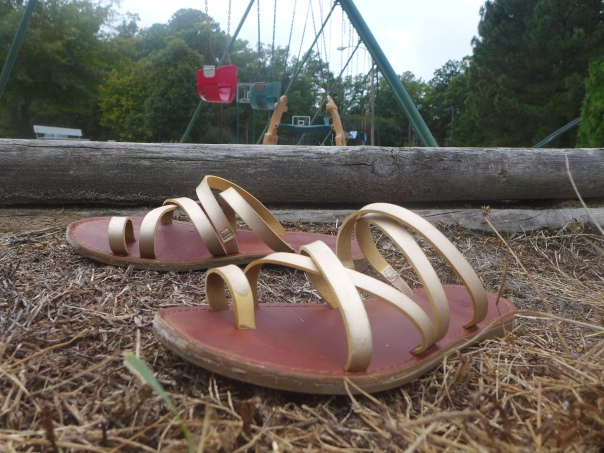
*My son is fairly careful and let’s off an alarm that brings judging parents from miles around when he’s anywhere close to danger. He also still requires a hand to hold when he saltates (no M&M’s required).
It has been a busy summer for my lab. Here is a taste of the beauty that I get to see when I sample the marsh. Most of the pictures below are from the Great Marsh in Massachusetts unless stated otherwise. What a gorgeous ecosystem sparkling with life.









A plant bug sits atop a muddy fiddler crab (female, Uca pugnax)


This week a young man in Australia was attacked by something while he was swimming in the ocean. His legs were bloodied and covered with hundreds of small bites. At the hospital, doctors were baffled about what bloodied the young man’s legs. The dad – who rocks in this story – went back into the water with a bloody steak and collected the small, flea-like animals. They were identified as amphipods, which are small crustaceans. If Sharknado has taught us anything, a movie about flesh-eating amphipods can’t be far now. Let’s see what that movie trailer might look like.
************
A young, beautiful mother sits on the beach and watches her charming son, who she can’t believe is growing up so fast, swim in the ocean. Gulls wheel overhead and waves roll gently. The sky blue.
Boy: Mom, watch me swim.
Mom: Okay.
[cue the Jaws-theme music rip-off]
Cello: Duh-nuh
Boy: You watching?
Mom: Yes, dear.
Cello: Duh-nuh
Cello: Duh-nuh
[cue that voiceover guy]
That Voiceover Guy: Just when you thought it was safe to go back into the water again.
Cello: Duh-nuh, Duh-nuh, Duh-nuh, etc.
The boy screams and grabs his leg. His mother runs into the waves and pulls him out. His legs are bleeding but there’s nothing on them. A handsome and rugged marine biologist who looks just a little bit dangerous but you know you’d feel safe in his arms, runs over.
Mom: What did this!?
Ruggedly handsome marine biologist: They’re amphipods.
Mom: Oh my go…wait, what the heck are amphipods?
Director: CUT!!
************
What the heck are amphipods? They are small crustaceans related to shrimp and crabs and lobsters. Typically, they aren’t larger than your thumbnail. If you’ve picked up seaweed on a beach, you’ve probably seen them. They are the small animals flipping and tumbling around like fleas. Those are amphipods. Sometimes called ‘sand fleas.’ Or ‘beach fleas.’ Or ‘beach hoppers.’ Or ‘sea fleas.’ The ‘flea’ name refers to the shape of their body (pressed from the sides) and the fact that they can flip around using their tails.
The media has used the term ‘sea lice’, but that really refers to an isopod, which can be parasitic on fish and look like the rolly-pollies (aka doodle-bugs) you find under logs.
Are amphipods the new marine menace? A pack of ravenous, flesh-eating beasts that roam the oceans looking for prey? Well, no. They do eat flesh, but typically not live flesh. We marine biologists (both the ruggedly handsome and other variety) don’t think of amphipods as predators but as scavengers that eat dead plants and animals. They’re more like tiny vultures swimming through the sea looking for something dead to stick their heads into rather than wild dogs looking to tear apart a baby deer.
I study amphipods in the salt marshes of Massachusetts and Louisiana (you can see pictures of them below). Just like on the beach, if you pick up seaweed in the marsh, hundreds of little crustaceans will flip and spring until they can hide in the grass. Not much of a terror. In terms of diet, these amphipods are more interested in a rotting veggie burger than a hunk of a marine-biologist.
Then why did they attack the young man’s legs in Australia? We’re not sure. Amphipods can bite humans – sometimes beach runners will have a bite or two – but they have rarely caused such damage. The best guess is that the amphipods were in a feeding frenzy and the young man’s legs happened to get in the way.
While I’ve been playful with this story, as a father, I too would have been worried. As a marine biologist, I am curious. It shows that we still have a lot to learn. The next time I pick up an amphipod I will check to see if it’s wearing a handkerchief and holding a knife and fork.
P.S. Now that we have flesh-eating amphipods in the news, soon I will write about zombie amphipods. Stay tuned. Duh-nuh…
P.P.S. If you enjoyed this article then please post it on Facebook, Twitter, or your favorite social media. And don’t forget to follow me.
Williamsburg, Virginia

I was riding my bike in my neighborhood when I saw a fiddler crab skitter across the blacktop. I stopped immediately to catch it because when it comes to marine life, I’m like a dog who can’t help but chase the rabbit. Plus, I don’t often see marine life skittering across blacktop in the middle of the day in June. I caught it. It was a red-jointed fiddler crab (this post reminds me that I need to write a post about fiddler crabs, but that’s for later).

Fiddler crabs live in burrows in beaches, salt marshes, and mangroves, not roads. But it’s not unusual to see fiddlers on roads that have been built right through the place where they live. In parts of coastal Virginia where the roads cut through the marsh, you can see herds of fiddler crabs roaming the road like cattle. The question is, why do fiddler crabs cross the road? One reason is that the road used to be a marsh where fiddlers grazed. Now they may cross the road for better pastures. Build a road through my house and I’m liable to wander onto it on my way to the kitchen for an avocado. But mind your honking in my house, I have a 2-year-old trying to sleep and an anxious cat who needs therapy.

To-get-to-the-otherside-for-a-snack is a fine answer for why fiddlers cross the road when the road is in their backyard. But the road I found the crab on today was at least 100 feet uphill from the marsh with a forest in between. I found seven wandering fiddlers total. What drives a fiddler to hike through the woods and then onto the highway? Fiddler crabs eat algae and little bits of dead plant found in the soil. I don’t think blacktop or frontyards or woodlands offer much forage for a fiddler.

My working hypothesis is that because we’ve had so much rain that it made the water too fresh for these marine crabs. But that hypothesis was shot down when I found a fine fiddler party in the marsh. My best guess is that because the temperatures were low and the road and forest were damp, they were simply brave crabs exploring new lands. There have been a lot of For Sale signs around. Now might be a good time to move.

In truth, I don’t really know why these crabs traveled so far. As I sit here daydreaming in rain, the why of it leaves my mind, like the crabs, to wander.
P.S. If you enjoy these posts, and of course you do, then please sign up for email updates! I don’t post often. Too much time chasing crabs.


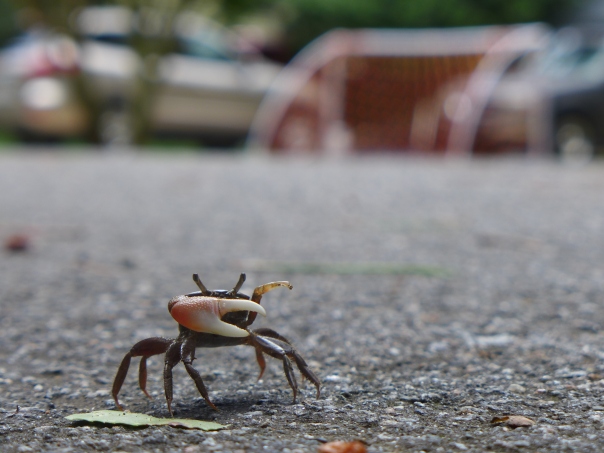
Jamestown, Virginia
I went down to the river today and found at least three* serpentine sunbathers draped across the branches of this bush. My best guess is that they were brown watersnakes, Nerodia taxispilota, based on my visit to the Virginia Herpetological Society’s awesome site. Can you find the three reptilian sunsoakers?
 I’ll update the post later in the week with the answers.
I’ll update the post later in the week with the answers.
*I say “at least three” because there could be more that I didn’t find.

Three weeks ago, my backyard exploded with lust as honeybees and bumblebees shoved their tongues down the throats of purple flowers. They were worse than a bunch of teenagers. For some, spring is a time of poems and romance. Not in my backyard. It is about satisfying a botanical lust and a zoological hunger.
In human reproduction, courtship may begin with a dance and eventually end with a screaming toddler who tells you ‘NO!’ as many times as you tell him. With their feet stuck in the ground, plants can’t dance so they have figured out another way of courting and reproducing with a partner. Some plants rely on wind or water to carry pollen from one plant to fertilize another. Other plants, like those in my backyard with purple flowers, rely on animals such as bees, bugs or bats. And all it takes is a little sugar to convince these animals to dance.
When winter ebbs and spring arrives, bees are hungry. Nectar is a fast meal. The bumblebees in my yard were so focused on feeding that I petted one on its fuzzy, tennis-ball thorax with my finger. The bee was not at all bothered. I taught my 21-month-old son how to pet bumblebees. And now when he sees a bee he sticks out his finger to pet it; I’m sure his mom will be thrilled.
I am amazed at how clever plants are. They have convinced an entirely different species to take part in their botanical lovemaking, and have done so with only a dab of sugar. I’m not nearly as clever. While the act of reproduction in humans is relatively uncomplicated, the act of convincing another human to reproduce with you is not. First dates, kissing the top of her ear because she turned her head when you went in for a kiss, handmade cards, not sure if she likes you, not sure if you like her, origami flowers, emails, drunk emails, break-ups, make-ups, bad movies, good movies you’re too nervous to watch, dinners with too much pepper and too much cabbage, dinners so good you forgot what you had, fights about nothing, fights about something, apologies for everything, hurt feelings, not being able to parallel park, building a garden together, telling her you’re tired when your exhausted because you want to impress her, farting in front of each other for the first time, wanting to build a life together, nerves about a new job and a new home, deciding to have a child that you will love more than anything but are terrified and excited about at the same time, teaching that child to pet bumblebees and then writing about it. Human reproduction is exhausting.*
I can’t imagine trying to convince another species to participate.
*I say as the one who did not give birth.
A five-lined skink* and I played peek-a-boo in the bushes today. Though I don’t know that he knew we were playing.

*At least, I think it’s a five-lined skink

Darlington, South Carolina
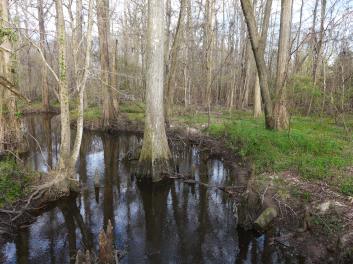 We walk through a cypress swamp full of trees that love to get their feet wet. Some are thick with gray shaggy beards of Spanish moss, while others are only tinseled with a sprig or two. Some trees wade in the middle of a creek, one that flows with water the color of sweet tea, though not nearly as sweet.
We walk through a cypress swamp full of trees that love to get their feet wet. Some are thick with gray shaggy beards of Spanish moss, while others are only tinseled with a sprig or two. Some trees wade in the middle of a creek, one that flows with water the color of sweet tea, though not nearly as sweet.
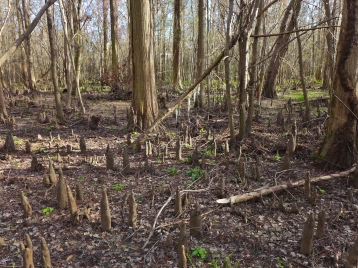
The walking path rises above a village of knees; stubby, leafless and unbranched versions of their tree parents. These cypress knees support the tree and let oxygen get down to the roots when flooded. A cypress tree doesn’t have to hold its breath underwater, it can breathe through its knees.
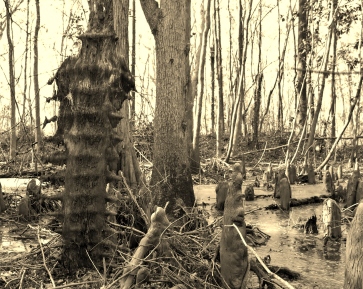
Among the knees and trees is a backbone standing as straight as a soldier. It was formed by hogwire fence nailed to a tree long ago. The tree grew around the fence, died, rotted and fell away, but the hogwire held its backbone erect.

A strip of twisting bark stands as tall as roof. Though we don’t know how it stands because it is a bark without its tree, as though the tree was suddenly frightened and ran off leaving a strip of its backside behind.

The swamp is abloom with flowers, but I am a poor botanist who just learned that Spanish moss is not a moss*. A red flower dots the swamp, a flower I will call a swamp rose, but it may not even be a rose. It may not even be a flower, just a moss masquerading as a flower, just as a flower masquerades as a moss – because Nature enjoys how clever it is.
 A crane fly rests on a tree. The crane fly is sometimes called a mosquito hawk, under the impression that it eats mosquitos. I am a better entomologist than botanist and I know that a crane fly does not eat mosquitos. What I don’t know is how it got this mistaken identity because all I’ve ever seen a crane fly do is beat itself stupid against the drywall in my house until it successfully wrapped itself in spider web.
A crane fly rests on a tree. The crane fly is sometimes called a mosquito hawk, under the impression that it eats mosquitos. I am a better entomologist than botanist and I know that a crane fly does not eat mosquitos. What I don’t know is how it got this mistaken identity because all I’ve ever seen a crane fly do is beat itself stupid against the drywall in my house until it successfully wrapped itself in spider web.
In the gravel parking lot a sign tells me about all the plants I saw, but I forget to remember all the information.
*Spanish moss is not a moss but a flowering plant like daffodils in your lawn. Unlike the daffodil, it uses the air as its soil. Spanish moss is in the same family of plants as pineapples, the bromeliads, a family of epiphytes (means “living on plants”) that use other plants as habitats like lichen on rocks. They are a tropical plant-family that require indirect sunlight and little water, which is why my red-tongued bromeliad died when I watered it daily and put it in a bright, sun-filled, bromeliad-killing window. My bromeliad simultaneously drowned and burned to death. I told you I was a terrible botanist. For the Spanish moss, it may seem strange to have a pineapple as your cousin, but we all have a strange pineapple cousin who doesn’t quite fit but just like the Spanish moss, you can’t pick who’s in your family. If we could, there’d be a lot of lonely pineapples.